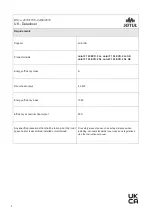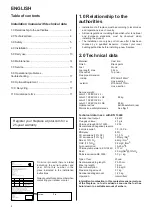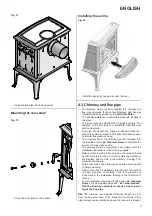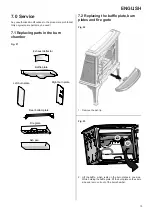
12
4.4 Performance check
Once the product has been assembled, always check the
control handles. These should move easily and work in a
satisfactory manner.
The Jøtul F 100 ECO.2 is equipped with the following
operating options:
Fig. 17
A
B
Ignition vent (A) - Air vent (B)
Pushed to the left:
Closed
Pushed to the right:
Open
4.5 Use
• Open both the air vent and the ignition vent by pushing
them to the right. If necessary, keep the door slightly open.
(Use a glove, for example, as the handle can become hot.)
• Place two medium sized logs in/out on each side of the
base.
N.B
. In order to avoid sooting on the glass, it is
important that the log is not placed adjacent to the glass
on the product.
• Place
fi
relighters or bark o
ff
the birch wood between the
logs. Stack some
fi
nely split wood on top in a criss-cross
pattern. Finally, place a medium-sized log on the top of the
pile. Light the
fi
re.
• Gradually increase the size of the
fi
re, but the wood should
not be stacked higher than the horizontal holes on the back
burn plate
.
• NB: The maximum height of the pile of the wood
should be just below the horizontal holes. The holes
must not be covered.
• Check that the afterburning (secondary combustion) starts.
This is best indicated by yellow,
fl
ickering
fl
ames under the
ba
ffl
e.
• Then regulate the rate of combustion to the desired level of
heating by adjusting the air vent
(
fi
g. 30 A).
• Close the stove door. It must always be closed when the
fi
re is lit.
• Operation with the air control or appliance dampers open
can cause excess smoke. The appliance must not be
operated with air controls, appliance dampers or door left
open except as directed in the instructions.
• Operation with the door open can cause excess smoke.
The appliance must not be operated with the appliance
door left open except as directed in the instructions.
Fig. 18
Adding
fi
rewood
Stoke the stove frequently but only add small amounts of fuel
at a time. If the stove is
fi
lled too full, the heat created may
cause extreme stress in the chimney. Add fuel to the
fi
re in
moderation. Avoid smouldering
fi
res as this produces the most
pollution. The
fi
re is best when it is burning well and the smoke
from the chimney is almost invisible.
Danger of overheating
The
fi
replace must never be used in a manner that causes
overheating.
Overheating occurs when there is too much fuel and/or too
much air so that too much heat develops. A sure sign of
overheating is when parts of the
fi
replace glow red. If this
happens, reduce the air vent opening immediately.
Seek professional advice if you suspect that the chimney is
not drawing properly (too much/too little draught). For further
information, see
«4.0 Installation» (Chimney and
fl
ue pipe)
.
How wind and weather a
ff
ect the stove
The performance of the stove can be a
ff
ected considerably by
the wind acting on the chimney at di
ff
erent strengths. It may
therefore be necessary to adjust the air supply to ensure good
combustion performance.
It might also be a good idea to install a damper in the
fl
ue pipe
so that the chimney draught can be regulated according to the
strength of the wind.
Condensation
Condensation in a
fi
replace /
fl
ue pipe / chimney may occur.
This may be caused by moist
fi
rewood or di
ff
erences in
temperature in the
fi
replace and environment.
ENGLISH



































